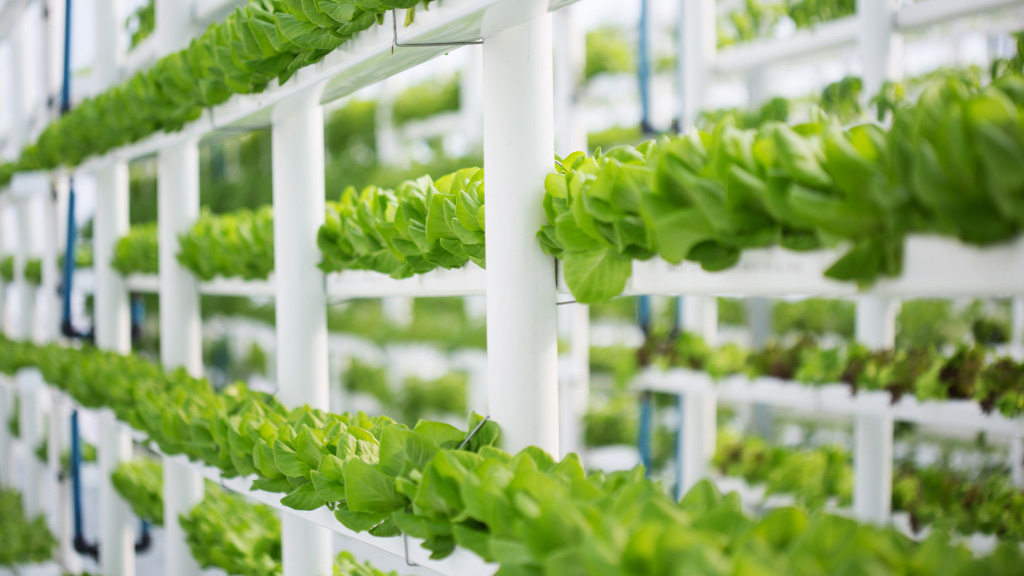Is it healthy for consumers? Is it profitable for farmers?
Hydroponic. You have no doubt seen the word. What exactly is it? How does hydroponic food differ from food grown in the ground? Why do farmers choose to grow hydroponically? Is it economical for them?
Lots of questions. Let’s have a go at answering them in this concise introduction to hydroponic foods.
What is hydroponics?
In traditional farming, plants get their nutrients from minerals and elements in the soil. In hydroponic farming, plants get these nutrients directly from water. The plants are elevated on racks. The roots are supported by substances like coconut fibre or vermiculite.
Fresh water flows in troughs below the plants, transporting calcium, phosphorus and magnesium to the roots dangling above. The water must be pH-neutral. (But then, soil must also be pH neutral to support healthy growth.)
Because the plants don’t need soil, hydroponic gardens are often indoor and multi-level. A farmer can grow many more plants per square metre.
Is hydroponic food nutritious?
As long as the plants are being fed the minerals they need, the food produced will be as nutritious as food grown in the ground.
What are the most popular hydroponic crops?
Because nutrients are delivered by water, the crops that suit the system best are leafy greens.
Lettuces are the most common crops grown hydroponically. They don’t develop a large root system. They don’t take up room beyond the actual edible part of the plant. They grow quickly.
When you buy whole lettuces at the farmer’s market or greengrocer, you’ll often see vermiculite clinging to the roots.
Herbs are also popular hydroponic crops. After lettuce, basil is the next most common hydroponic crop. Herbs don’t require a lot of nutrients, so growing them is relatively easy – and easier in the controlled environment of a hydroponic farm.
Microgreens are loved by chefs for the colourful finishing touches they bring to a dish. Because they are harvested just 4 to 10 days after sprouting, they are also a popular hydroponic crop.
Some tomato varieties are grown hydroponically. Strawberries often are.
Is hydroponics profitable for farmers?
An obvious cost when creating a hydroponic farm is construction – the building, lighting, racks and water system. On the other hand, a farmer only needs to purchase enough land for the hydroponics sheds.
The most popular crops are fast-growing and the environment is controlled. Farmers can harvest shortly after setting up the hydroponic farm.
A crop that might take 2 months to be ready in the field can be ready in 20 days when grown hydroponically.
On a hydroponic farm, harvest is continuous. Farmers can get as many as six times the crops they’d get from a traditional farm. In the case of micro-herbs, there could be 50 harvests in a year. And the margins are high. The profit on lettuces and microherbs can be as much as 40%.
Can hydroponics solve climate change?
Farmers are struggling to adapt to changes in climate. Seasons are changing. Yields are falling. Farmers are planting drought-tolerant varieties of vegetables. Because the environment in a hydroponic facility is controlled, produce isn’t susceptible to the vagaries of weather.
Climate change is also making some areas unsuitable for farming. Again, hydroponics circumvents this.
And because the world is running out of arable land, hydroponics is often seen as a solution because a farm can be constructed anywhere or installed in an existing industrial space.
When we buy vegetables at the markets, we don’t think about how they are grown. Increasingly, those vegetables won’t come from a farm as we know it. They’ll grow in multistorey racks in a temperature-controlled build.
Hydroponics are here now. And they have a place in the future of farming.
If you’d like a chance to invest in Australian farmers’ produce, sign up as a member of the Invest in Farming Co-operative. You can do that here.




